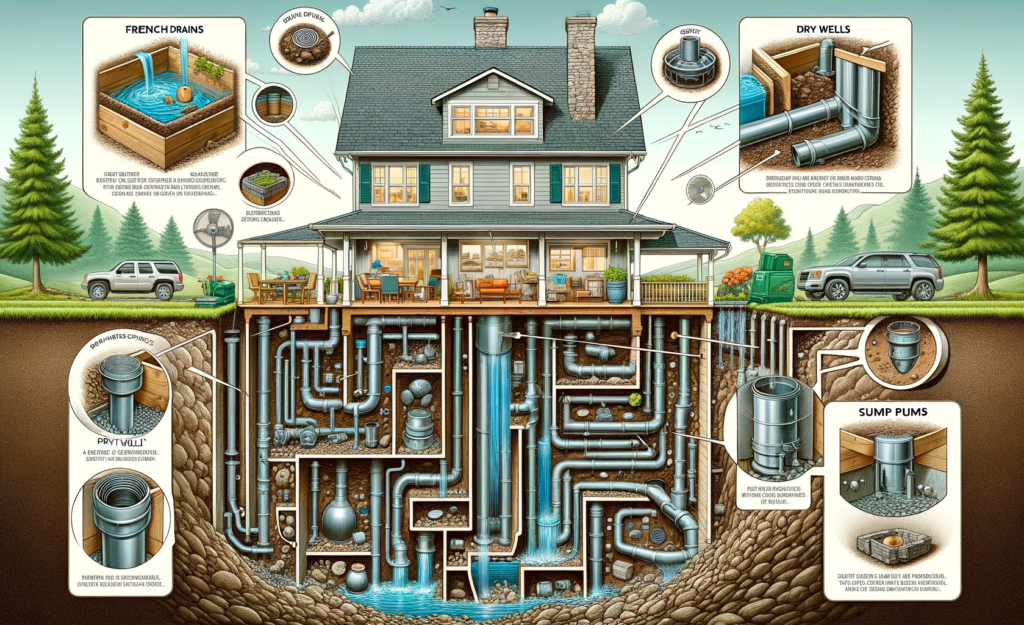Understanding the Types of Home Drainage Systems

Introduction to Home Drainage Systems
If you’ve ever experienced water pooling in your yard or dampness in your basement, you understand the significance of proper drainage around your home. I’m here to guide you through the various types of home drainage systems, offering insights and tailored solutions for safeguarding your home from water damage. From simple gutter arrangements to more complex subsurface layouts, having a clear understanding of these systems is crucial for maintaining the integrity of your home.
Importance of Proper Home Drainage
I can’t stress enough how essential it is to manage stormwater and runoff effectively. Proper home drainage is not just about preventing puddles; it’s about protecting your home’s foundation, preventing soil erosion, and even deterring pests. As we delve into the specifics, bear in mind that every house and landscape is unique, which means custom drainage strategies are often necessary.
| Key Takeaways |
|---|
| Knowledge – Understanding the types of drainage systems available |
| Protection – Importance of preventing water damage to your home |
| Customization – Tailoring solutions to fit specific landscapes |
Types of Home Drainage Systems
Surface Drainage Systems
Surface drainage systems are your first line of defense against water accumulation. These systems are designed to move water away from your home quickly and efficiently, utilizing strategically placed slopes and channels. It involves grading the property to create a natural flow that directs water towards a street, storm drain, or other designated runoff areas.
Subsurface Drainage Systems (French Drains)

Subsurface or French drain systems lie beneath the surface of your yard. They’re ideal for consistently wet areas and work by redirecting water away from your home through a system of pipes. These pipes, typically surrounded by gravel, collect water and direct it to a safer location, such as a drainage ditch or well.
Slope Drainage Systems
Properties on a slope can benefit greatly from slope drainage systems. These systems use pipes to direct water from high to lower ground, leveraging gravity to prevent water from saturating soil and causing stability issues. It’s vital to engineer these systems well to avoid any backflow towards your home.
Downspout and Gutter Systems

Gutters and downspouts are arguably the most recognized components of home drainage systems. They catch water from your roof and channel it away from your home’s foundation. Ensuring these systems are clear and functioning is a simple yet impactful way to prevent potential water damage.
Installation Considerations for Home Drainage
Assessing Your Home’s Drainage Needs
Before installing any drainage system, you must evaluate your home’s specific needs. Consider factors like landscape, local climate, and soil type. An assessment can reveal what system or combination thereof will work best for your situation. Sometimes, it might be a simple case of improving your home’s gutter system, while other situations might call for a more elaborate French drain installation.
Planning and Designing Drainage Systems
Proper planning and design are paramount to the success of any drainage system. A well-thought-out design will ensure that water is not only redirected away from your home but that it’s done so in a manner that doesn’t adversely affect your neighbours or the local ecosystem. It’s often worth consulting with professional contractors who can offer valuable insight into the best systems and practices for your area.
Common Residential Drainage Problems
Identifying and Addressing Issues
Common problems with residential drainage systems can range from clogged gutters to improperly installed drain pipes. Recognizing these issues early on can save you from costly repairs and extensive damage in the long run. Regular maintenance, such as cleaning gutters and inspecting drain lines, is essential for the longevity of your drainage system.
Integrating Drain Maintenance Tips
When it comes to maintenance, small tasks can lead to big results. For instance, simply extending your downspouts can significantly improve your home’s ability to handle heavy rainfall. Regular inspections, particularly before and after severe weather, will help keep everything in working order.
Eco-Friendly and Cost-Effective Drainage Solutions
Green Practices for Drainage
Adopting eco-friendly drainage solutions is not only good for the environment but can also be cost-effective. Incorporating elements such as rain gardens or permeable paving can minimize runoff while enhancing the beauty and functionality of your outdoor space. These solutions help to recharge groundwater and mitigate the effects of heavy precipitation events.

Balancing Budget and Efficiency
Balancing the budget with efficiency is often a primary concern for homeowners. There are a variety of cost-effective drainage solutions that do not require a significant upfront investment. Simple adjustments, when correctly implemented, can make a big difference in preventing water from pooling near your home.
Quote:
“Investing in the right drainage system for your home is a cost-effective way to prevent expensive repairs down the line.” – Expert Drainage Contractor
Drainage Challenges in Older Homes and High Rainfall Areas
Retrofitting Drain Systems
Older homes may pose unique challenges due to their outdated or non-existent drainage systems. Retrofitting these properties with modern drainage solutions often requires careful planning and adaptation to the existing landscape and infrastructure.
Managing Soil Type and Drainage Impact
In areas with high rainfall, managing excess water becomes increasingly complex. The soil type also significantly impacts how well your drainage system performs. Understanding these factors is crucial when planning your home’s drainage strategy.
Enhancing Home Value and Health Through Drainage
The Impact of Drainage on Foundation Health
The foundation of a home is often out of sight and out of mind, but poor drainage can lead to severe problems, such as foundation cracks and structural issues. Investing in a functional, well-maintained drainage system not only contributes to the overall health of your home but can also enhance its market value.
Drainage as an Investment in Home Value
Homebuyers are becoming increasingly aware of the importance of drainage. A sound drainage system can be a selling point for your home, signaling to potential buyers that the property is well-cared for and less likely to have water-related problems.
Innovative Drainage Products and Smart Solutions
The Role of Technology in Drainage
With the advent of smart home technology, drainage systems have also seen considerable innovation. From sensors that monitor moisture levels to automating drainage processes, the possibilities are exciting. Staying informed about these innovative products can offer convenience and peace of mind.
Tips for Seasonal Drainage Care
Seasonally adjusting your drainage care can be highly effective. For example, during fall, it’s important to keep leaves out of gutters and drains to prevent blockages. Conversely, in the spring, checking for any damage caused by winter weather and ensuring all components are in optimal condition is advisable.
Conclusion: Taking Action on Your Home Drainage
Armed with this information, you’re now better equipped to evaluate and enhance your home’s drainage system. Remember, timely upgrades and maintenance can save you from the headaches of water damage repairs. Consider this article as the starting point for taking proactive steps toward a drier, healthier home. Don’t hesitate to reach out to professionals for help in complex scenarios, and always keep an eye out for the latest in eco-friendly and innovative drainage solutions.
FAQ Section:
- What are the most common types of home drainage systems? Surface, subsurface, slope, and downspout/gutter systems are the most common.
- How often should I inspect my home’s drainage system? It’s wise to inspect it bi-annually and after severe weather events.
- Is it possible to retrofit an older home with a new drainage system? Yes, with proper planning and expert guidance, you can retrofit older homes with efficient drainage systems.
Remember, no issue is too small when it comes to the health of your home’s drainage system. Staying informed and vigilant is the key to preventing bigger, more costly problems down the road. Now, if everything looks in order, we can finalize the draft and conclude the article.




